Evaluating the Topological Surface Properties of Cu/Cr Thin Films Using 3D Atomic Force Microscopy Topographical Maps
Abstract
:1. Introduction
2. Materials and Methods
3. Results and Discussion
3.1. EDS Analysis
3.2. Height-Based Analysis
3.3. Minkowski Functionals
3.4. Analysis of the Films’ Spatial Microtexture
3.5. Multifractal Analysis
4. Conclusions
Supplementary Materials
Author Contributions
Funding
Institutional Review Board Statement
Informed Consent Statement
Data Availability Statement
Conflicts of Interest
References
- Tagantsev, A.K.; Gerra, G. Interface-induced phenomena in polarization response of ferroelectric thin films. J. Appl. Phys. 2006, 100, 051607. [Google Scholar] [CrossRef]
- Korotcenkov, G. Metal Oxide-Based Thin Film Structures: Formation, Characterization and Application of Interface-Based Phenomena; Pryds, N., Esposito, V., Eds.; Elsevier: Amsterdam, The Netherlands, 2018; ISBN 978-0-12-811166-6. [Google Scholar]
- Lee, H.Y.; Al Ezzi, M.M.; Raghuvanshi, N.; Chung, J.Y.; Watanabe, K.; Taniguchi, T.; Garaj, S.; Adam, S.; Gradecak, S. Tunable Optical Properties of Thin Films Controlled by the Interface Twist Angle. Nano Lett. 2021, 21, 2832–2839. [Google Scholar] [CrossRef] [PubMed]
- Agrawal, P.; Büttner, F.; Lemesh, I.; Schlotter, S.; Beach, G.S. Measurement of interfacial Dzyaloshinskii-Moriya interaction from static domain imaging. Phys. Rev. B 2019, 100, 104430. [Google Scholar] [CrossRef]
- Xiong, S.; Yin, S.; Wang, Y.; Kong, Z.; Lan, J.; Zhang, R.; Gong, M.; Wu, B.; Wang, X. Organic/inorganic electrochromic nanocomposites with various interfacial interactions: A review. Mater. Sci. Eng. B 2017, 221, 41–53. [Google Scholar] [CrossRef]
- Anderoglu, O.; Misra, A.; Wang, H.; Ronning, F.; Hundley, M.F.; Zhang, X. Epitaxial nanotwinned Cu films with high strength and high conductivity. Appl. Phys. Lett. 2008, 93, 083108. [Google Scholar] [CrossRef]
- Mehmood, B.; Khan, M.I.; Iqbal, M.; Mahmood, A.; Al-Masry, W. Structural and optical properties of Ti and Cu codoped ZnO thin films for photovoltaic applications of dye sensitized solar cells. Int. J. Energy Res. 2021, 45, 2445–2459. [Google Scholar] [CrossRef]
- Roa, S.; Sirena, M. Size effects on the optimization of the mechanical resistance and the electrical conductivity of Cu thin films. Mater. Today Commun. 2021, 28, 102572. [Google Scholar] [CrossRef]
- Chang, C.A. Reduced Cu-Cr mixing and reduced Pt-Cu interdiffusion by oxygen in Cu/Cr and Pt/Cu/Cr thin films. J. Appl. Phys. 1982, 53, 7092–7094. [Google Scholar] [CrossRef]
- Li, X.G.; Cao, L.F.; Zhang, J.Y.; Li, J.; Zhao, J.T.; Feng, X.B.; Wang, Y.Q.; Wu, K.; Zhang, P.; Liu, G.; et al. Tuning the microstructure and mechanical properties of magnetron sputtered Cu-Cr thin films: The optimal Cr addition. Acta Mater. 2018, 151, 87–99. [Google Scholar] [CrossRef]
- Hansen, M.; Anderko, K.; Salzberg, H.W. Constitution of binary alloys. J. Electrochem. Soc. 1958, 105, 260C. [Google Scholar] [CrossRef]
- Merche, D.; Vandencasteele, N.; Reniers, F. Atmospheric plasmas for thin film deposition: A critical review. Thin Solid Film. 2012, 520, 4219–4236. [Google Scholar] [CrossRef]
- Ahmadpourian, A.; Luna, C.; Boochani, A.; Arman, A.; Achour, A.; Rezaee, S.; Naderi, S. The effects of deposition time on surface morphology, structural, electrical and optical properties of sputtered Ag-Cu thin films. Eur. Phys. J. Plus 2016, 131, 1–7. [Google Scholar] [CrossRef]
- Ghobadi, N.; Ganji, M.; Luna, C.; Arman, A.; Ahmadpourian, A. Effects of substrate temperature on the properties of sputtered TiN thin films. J. Mater. Sci. Mater. Electron. 2016, 27, 2800–2808. [Google Scholar] [CrossRef]
- Vahl, A.; Veziroglu, S.; Henkel, B.; Strunskus, T.; Polonskyi, O.; Aktas, O.C.; Faupel, F. Pathways to tailor photocatalytic performance of TiO2 thin films deposited by reactive magnetron sputtering. Materials 2019, 12, 2840. [Google Scholar] [CrossRef]
- Salunkhe, P.; AV, M.A.; Kekuda, D. Investigation on tailoring physical properties of Nickel Oxide thin films grown by dc magnetron sputtering. Mater. Res. Express 2020, 7, 016427. [Google Scholar] [CrossRef]
- Zhang, Q.; Zhang, Z.; Liu, Y.; Wang, Z. Crystallization and Composition of Ni-C/Ti Multilayer with Varied Ni-C Thickness. Coatings 2022, 12, 1144. [Google Scholar] [CrossRef]
- Kim, H.K.; Kim, S.M.; Lee, S.Y. Mechanical Properties and Thermal Stability of CrZrN/CrZrSiN Multilayer Coatings with Different Bilayer Periods. Coatings 2022, 12, 1025. [Google Scholar] [CrossRef]
- Mwema, F.M.; Oladijo, O.P.; Sathiaraj, T.S.; Akinlabi, E.T. Atomic force microscopy analysis of surface topography of pure thin aluminum films. Mater. Res. Express 2018, 5, 046416. [Google Scholar] [CrossRef]
- Song, J.; Zhou, Y.; Padture, N.P.; Huey, B.D. Anomalous 3D nanoscale photoconduction in hybrid perovskite semiconductors revealed by tomographic atomic force microscopy. Nat. Commun. 2020, 11, 3308. [Google Scholar] [CrossRef]
- Mantz, H.; Jacobs, K.; Mecke, K. Utilizing Minkowski functionals for image analysis: A marching square algorithm. J. Stat. Mech. Theory Exp. 2008, 12, 12015. [Google Scholar] [CrossRef]
- Korpi, A.G.; Ţălu, Ş.; Bramowicz, M.; Arman, A.; Kulesza, S.; Pszczolkowski, B.; Jurečka, S.; Mardani, M.; Luna, C.; Balashabadi, P.; et al. Minkowski functional characterization and fractal analysis of surfaces of titanium nitride films. Mater. Express 2019, 6, 086463. [Google Scholar] [CrossRef]
- Lighvan, Y.L. Morphological characteristics and Minkowski functionals of Ag—DLC thin films: A case study on different metal substrates. Vak. Forsch. Prax. 2022, 34, 38–43. [Google Scholar] [CrossRef]
- Mwema, F.M.; Akinlabi, E.T.; Oladijo, O.P.; Fatoba, O.S.; Akinlabi, S.A.; Ţălu, Ş. Advances in manufacturing. In Modern Manufacturing Processes, 1st ed.; Kumar, K., Davim, J.P., Eds.; Woodhead Publishing Reviews: Mechanical Engineering Series; Woodhead Publishing: Cambridge, UK, 2020; pp. 13–39. [Google Scholar] [CrossRef]
- Ţălu, Ş.; Matos, R.S.; Pinto, E.P.; Rezaee, S.; Mardani, M. Stereometric and fractal analysis of sputtered Ag-Cu thin films. Surf. Interfaces 2020, 21, 100650. [Google Scholar] [CrossRef]
- Aminirastabi, H.; Xue, H.; Mitić, V.V.; Lazović, G.; Ji, G.; Peng, D. Novel fractal analysis of nanograin growth in BaTiO3 thin film. Mater. Phys. 2020, 239, 122261. [Google Scholar] [CrossRef]
- Ţălu, Ş.; Stach, S.; Valedbagi, S.; Bavadi, R.; Elahi, S.M.; Ţălu, M. Multifractal characteristics of titanium nitride thin films. Mater. Sci. 2015, 33, 541–548. [Google Scholar] [CrossRef]
- Ghosh, K.; Pandey, R.K. Fractal and multifractal analysis of In-doped ZnO thin films deposited on glass, ITO, and silicon substrates. Appl. Phys. A 2019, 125, 98. [Google Scholar] [CrossRef]
- Shakoury, R.; Rezaee, S.; Mwema, F.; Luna, C.; Ghosh, K.; Jurečka, S.; Ţălu, Ş.; Arman, A.; Grayeli Korpi, A. Multifractal and optical bandgap characterization of Ta2O5 thin films deposited by electron gun method. Opt. Quant. Electron. 2020, 52, 95. [Google Scholar] [CrossRef]
- Leprince-Wang, Y.; Yu-Zhang, K. Study of the growth morphology of TiO2 thin films by AFM and TEM. Surf. Coat. Technol. 2001, 140, 155–160. [Google Scholar] [CrossRef]
- Arman, A.; Ţălu, Ş.; Luna, C.; Ahmadpourian, A.; Naseri, M.; Molamohammadi, M. Micromorphology characterization of copper thin films by AFM and fractal analysis. J. Mater. Sci. Mater. Electron. 2015, 26, 9630–9639. [Google Scholar] [CrossRef]
- Romaguera-Barcelay, Y.; Ţălu, Ş.; Matos, R.S.; Oliveira, R.M.P.B.; Moreira, J.A.; de Cruz, J.P.; da Fonseca Filho, H.D. Fractal-Stereometric Correlation of Nanoscale Spatial Patterns of GdMnO3 Thin Films Deposited by Spin Coating. Appl. Sci. 2021, 11, 3886. [Google Scholar] [CrossRef]
- Haitjema, H. Uncertainty in measurement of surface topography. Surf. Topogr. Metrol. Prop. 2015, 3, 035004. [Google Scholar] [CrossRef]
- Podulka, P. Reduction of influence of the high-frequency noise on the results of surface topography measurements. Materials 2021, 14, 333. [Google Scholar] [CrossRef] [PubMed]
- ISO 25178-2:2012. Geometrical Product Specifications (GPS)—Surface Texture: Areal—Part 2: Terms, Definitions and Surface Texture Parameters. Available online: http://www.iso.org (accessed on 15 September 2022).
- Mwema, F.M.; Akinlabi, E.T.; Oladijo, O.P. Effect of Substrate Type on the Fractal Characteristics of AFM Images of Sputtered Aluminium Thin Films. Mater. Sci. 2019, 26, 49–57. [Google Scholar] [CrossRef]
- Qi, H.J.; Huang, L.H.; Tang, Z.S.; Cheng, C.F.; Shao, J.D.; Fan, Z.X. Roughness evolution of ZrO2 thin films grown by reactive ion beam sputtering. Thin Solid Film. 2003, 444, 146–152. [Google Scholar] [CrossRef]
- Lobo, R.F.M.; Pereira-da-Silva, M.A.; Raposo, M.; Faria, R.M.; Oliveira, O.N.; Pereira-da-Silva, M.A.; Faria, R.M. In Situ thickness measurements of ultra-thin multilayer polymer films by atomic force microscopy. Nanotechnology 1999, 10, 389–393. [Google Scholar] [CrossRef]
- Wei, C.; He, H.; Deng, Z.; Shao, J.; Fan, Z. Study of thermal behaviors in CO2 laser irradiated glass. Opt. Eng. 2005, 44, 044202. [Google Scholar] [CrossRef]
- Tummala, R.R.; Friedberg, A.L. Thermal Expansion of Composite Materials. J. Appl. Phys. 1970, 41, 5104–5107. [Google Scholar] [CrossRef]
- Tien, C.-L.; Lin, T.-W. Out-of-Plane Thermal Expansion Coefficient and Biaxial Young’s Modulus of Sputtered ITO Thin Films. Coatings 2021, 11, 153. [Google Scholar] [CrossRef]
- Jin, S.; Rajgopal, S.; Mehregany, M. Silicon carbide pressure sensor for high temperature and high pressure applications: Influence of substrate material on performance. In Proceedings of the 2011 16th International Solid-State Sensors, Actuators Microsystems Conference, Beijing, China, 5–9 June 2011; pp. 2026–2029. [Google Scholar] [CrossRef]
- Blateyron, F. Characterisation of Areal Surface Texture; Springer: Berlin/Heidelberg, Germany, 2013. [Google Scholar] [CrossRef]
- Matos, R.S.; Pinheiro, B.S.; Souza, I.S.; Paes de Castro, R.R.; Ramos, G.Q.; Pinto, E.P.; Silva, R.S.; da Fonseca Filho, H.D. 3D micromorphology evaluation of kefir microbial films loaded with extract of Amazon rainforest fruit Cupuaçu. Micron 2021, 142, 102996. [Google Scholar] [CrossRef]
- Derchi, G.; Vano, M.; Barone, A.; Covani, U.; Diaspro, A.; Salerno, M. Bacterial adhesion on direct and indirect dental restorative composite resins: An in vitro study on a natural biofilm. J. Prosthet. Dent. 2017, 117, 669–676. [Google Scholar] [CrossRef]
- Arns, C.H.; Knackstedt, M.A.; Mecke, K.R. Characterisation of irregular spatial structures by parallel sets and integral geometric measures. Colloids Surf. A Physicochem. Eng.Asp. 2004, 241, 351–372. [Google Scholar] [CrossRef]
- Schmähling, J.; Hamprecht, F.A. Generalizing the Abbott–Firestone curve by two new surface descriptors. Wear 2007, 262, 1360–1371. [Google Scholar] [CrossRef]
- Matos, R.S.; Ţălu, Ş.; Mota, G.V.S.; Pinto, E.P.; Pires, M.A.; Abraçado, L.G.; Ferreira, N.S. Correlating Structure and Morphology of Andiroba Leaf (Carapa guianensis Aubl.) by Microscopy and Fractal Theory Analyses. Appl. Sci. 2021, 11, 5848. [Google Scholar] [CrossRef]
- Ţălu, Ş.; Abdolghaderi, S.; Pinto, E.P.; Matos, R.S.; Salerno, M. Advanced fractal analysis of nanoscale topography of Ag/DLC composite synthesized by RF-PECVD. Surf. Eng. 2020, 36, 713–719. [Google Scholar] [CrossRef]
- Matos, R.S.; Lopes, G.A.C.; Ferreira, N.S.; Pinto, E.P.; Carvalho, J.C.T.; Figueiredo, S.S.; Oliveira, A.F.; Zamora, R.R.M. Superficial Characterization of Kefir Biofilms Associated with Açaí and Cupuaçu Extracts. Arab. J. Sci. Eng. 2018, 43, 3371–3379. [Google Scholar] [CrossRef]
- Romaguera-Barcelay, Y.; Matos, R.S.; Pedraça, A.S.; Perez de Cruz, J.; Brito, W.R.; Oliveira, R.M.P.B.; Filho, H.D.F. Advanced spatial investigation of 3D nanoscale topography of DyMnO3 thin films. Phys. B Condens. Matter. 2021, 623, 413360. [Google Scholar] [CrossRef]
- Fonseca Filho, H.D.; Pires, M.P.; Souza, P.L.; Matos, R.S.; Prioli, R. Investigation of the morphological and fractal behavior at nanoscale of patterning lines by scratching in an atomic force microscope. Microsc. Res. Tech. 2022, 85, 1046–1055. [Google Scholar] [CrossRef]
- Yadav, M.; Yadav, R.P.; Priya, P.K.; Bhasker, H.P.; Ţălu, Ş.; Mittal, A.K.; Matos, R.S. Effect of Fe Doping on the Surface Morphology and Supercapacitor Properties of Sr(OH)2 Thin Films: A Fractal Approach. J. Phys. Chem. C 2021, 125, 22827–22836. [Google Scholar] [CrossRef]
- de Oliveira, L.M.; Matos, R.S.; Campelo, P.H.; Sanches, E.A.; da Fonseca Filho, H.D. Evaluation of the nanoscale surface applied to biodegradable nanoparticles containing Allium sativum essential oil. Mater. Lett. 2020, 275. [Google Scholar] [CrossRef]
- Barabási, A.-L.; Vicsek, T. Multifractality of self-affine fractals. Phys. Rev. A 1991, 44, 2730–2733. [Google Scholar] [CrossRef]
- Ţălu, Ş.; Stach, S. Multifractal characterization of unworn hydrogel contact lens surfaces. Polym. Eng. Sci. 2014, 54, 1066–1080. [Google Scholar] [CrossRef]
- Shakoury, R.; Arman, A.; Ţălu, Ş.; Ghosh, K.; Rezaee, S.; Luna, C.; Mwema, F.; Sherefat, K.; Salehi, M.; Mardani, M. Optical properties, microstructure, and multifractal analyses of ZnS thin films obtained by RF magnetron sputtering. J. Mater. Sci. Mater. Electron. 2020, 31, 5262–5273. [Google Scholar] [CrossRef]
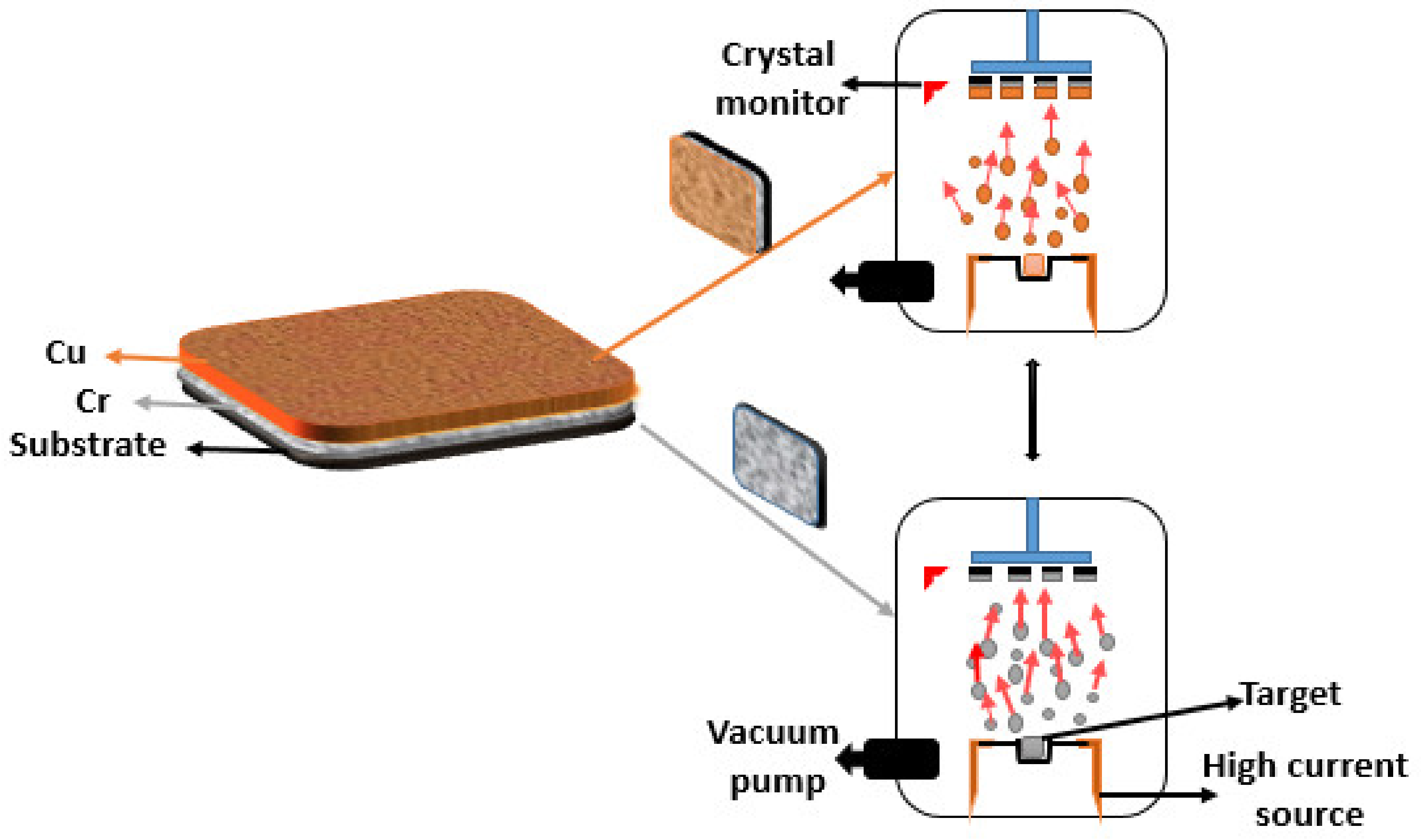
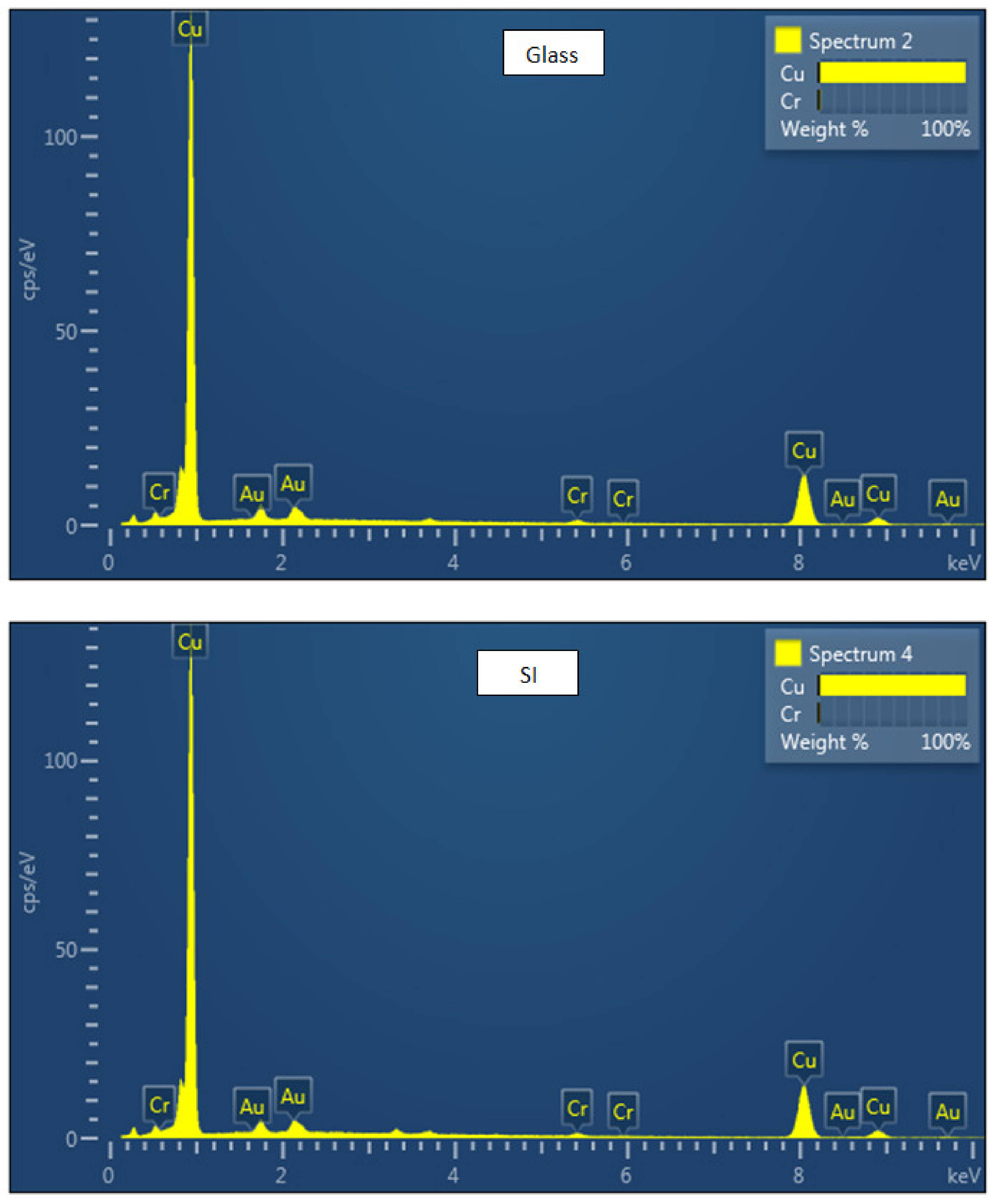
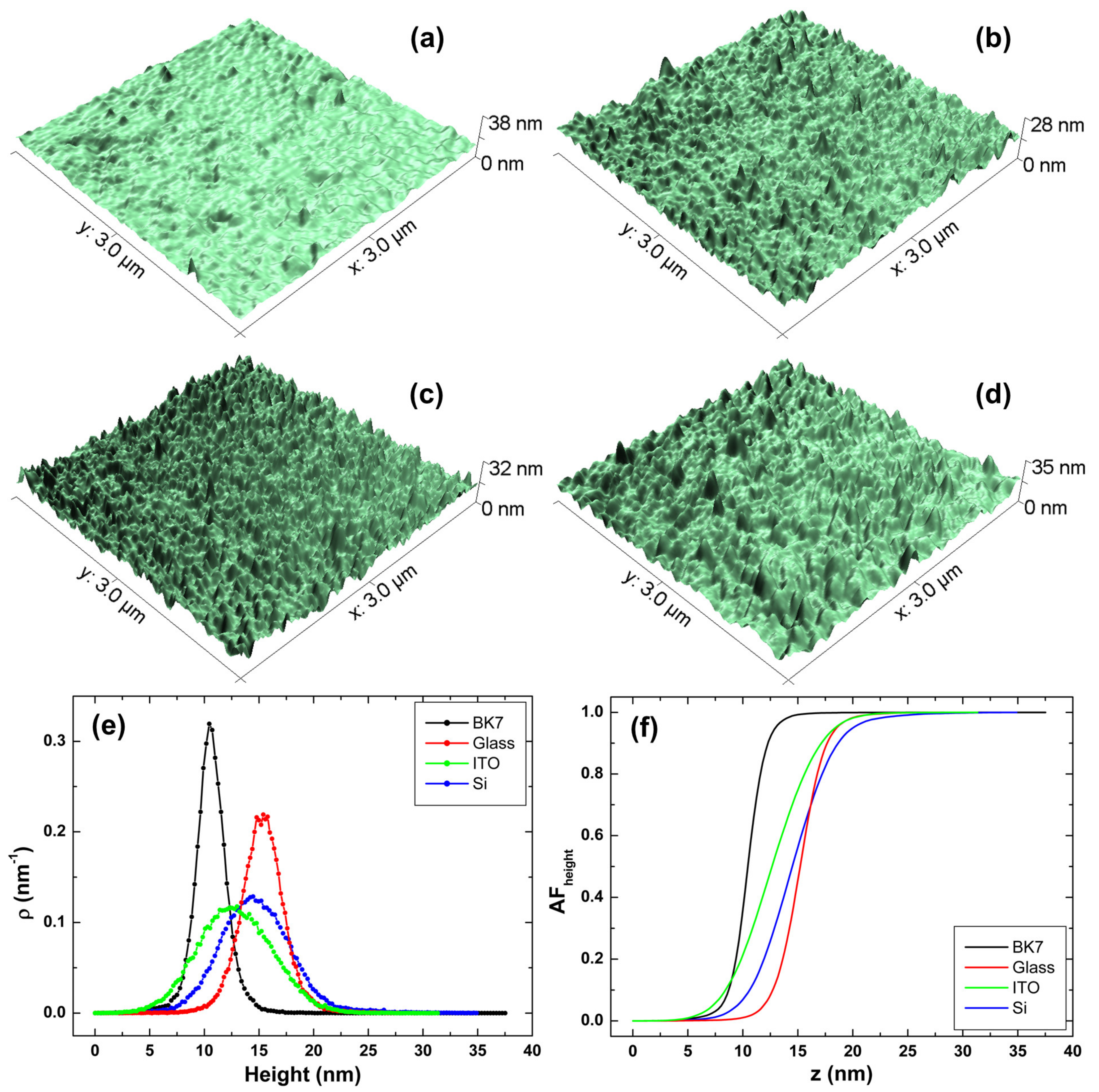
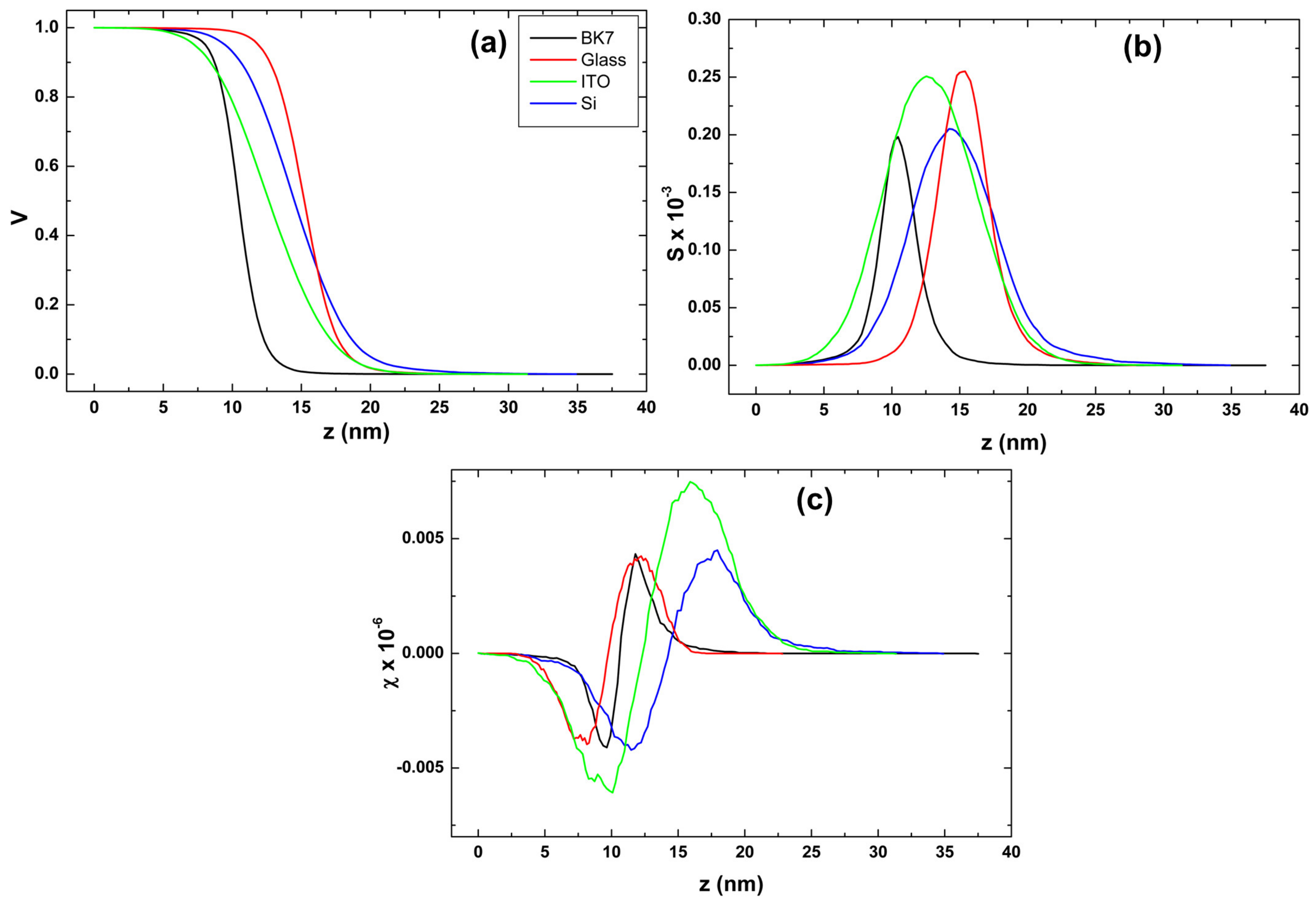
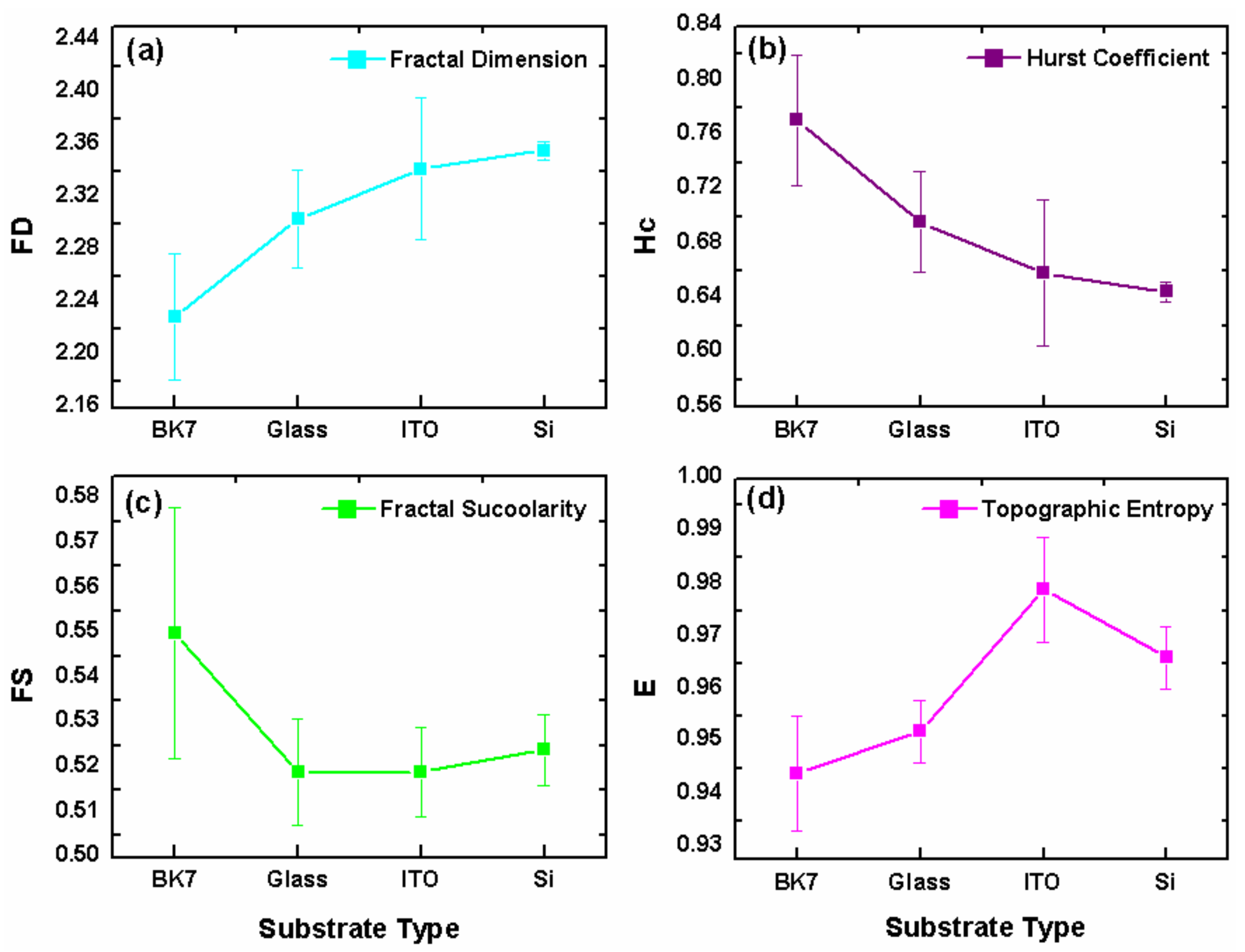
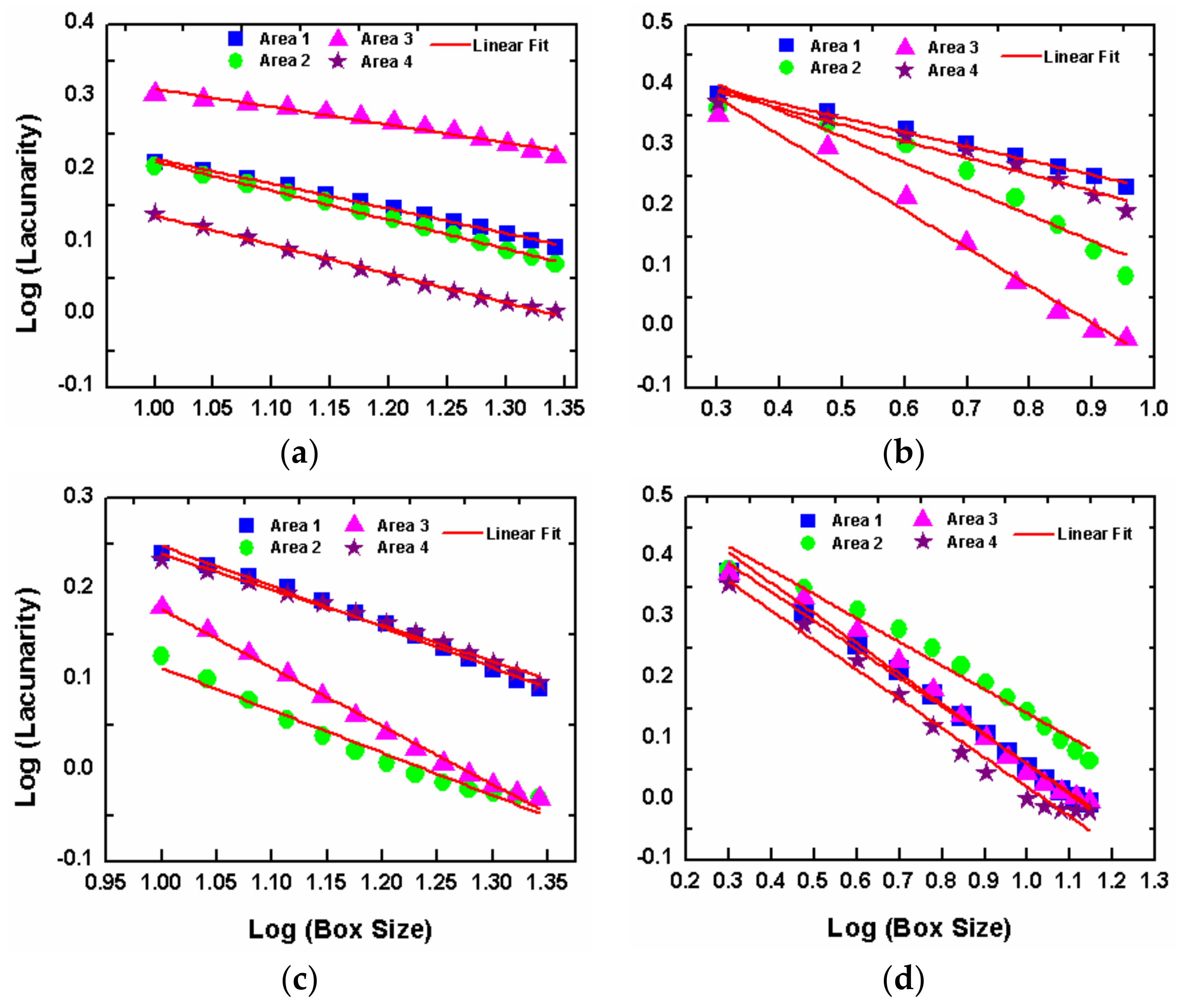
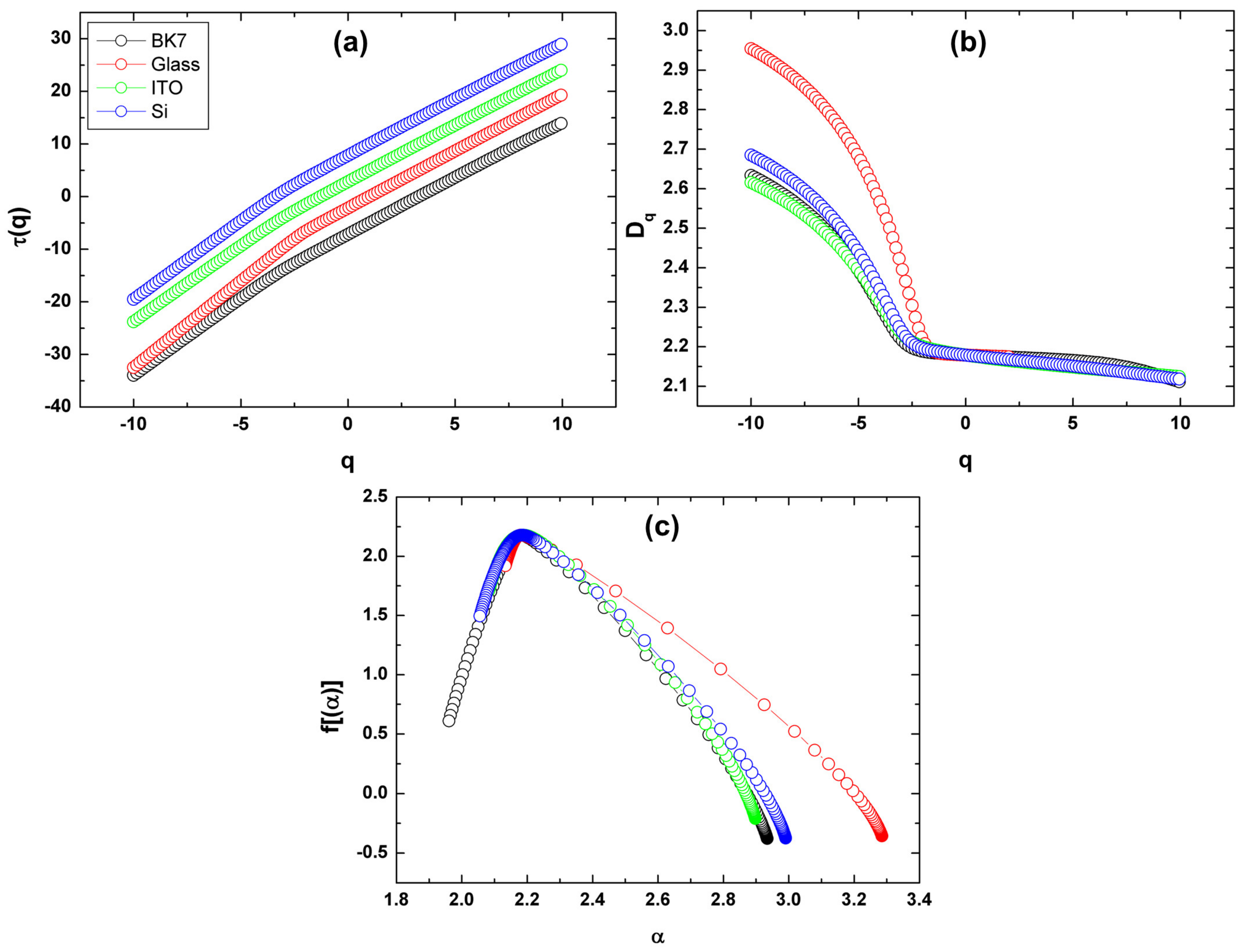
| Target | Working Pressure (mbar) | Deposition Rate (nm/s) | Intensity Current (A) | Thickness (nm) | Working Temperature (°C) |
|---|---|---|---|---|---|
| Cr | 8 × 10−5 | 0.1 | 25–35 | 25 | 150 |
| Cu | 8 × 10−5 | 3 | 35–40 | 250 | 70 |
| Sample | Element (wt%) | |
|---|---|---|
| Cr | Cu | |
| Glass | 1.38 | 1.3 |
| Si | 98.62 | 98.7 |
| Parameter | Unit | Bk7 | Glass | ITO | Si |
|---|---|---|---|---|---|
| Sq | [nm] | 1.62 ± 0.28 | 1.90 ± 0.22 | 3.20 ± 0.22 | 3.32 ± 0.42 |
| Sa | [nm] | 1.18 ± 0.20 | 1.40 ± 0.18 | 2.85 ± 0.44 | 2.50 ± 0.27 |
| Ssk * | [-] | 0.23 ± 0.13 | 0.60 ± 0.35 | 0.36 ± 0.19 | 0.83 ± 0.47 |
| Sku * | [-] | 5.84 ± 2.85 | 4.08 ± 1.54 | 1.24 ± 0.98 | 3.27 ± 1.72 |
| Parameter | BK7 | Glass | ITO | Si |
|---|---|---|---|---|
| f(αmax) | −0.378 | −0.356 | −0.210 | −0.374 |
| f(αmin) | 0.611 | 1.919 | 1.709 | 1.495 |
| Δf = f(αmin) − f(αmax) | 0.989 | 2.275 | 1.919 | 1.869 |
| αmax | 2.934 | 3.285 | 2.898 | 2.991 |
| αmin | 1.961 | 2.133 | 2.083 | 2.055 |
| Δα = αmax − αmin | 0.973 | 1.152 | 0.815 | 0.936 |
Publisher’s Note: MDPI stays neutral with regard to jurisdictional claims in published maps and institutional affiliations. |
© 2022 by the authors. Licensee MDPI, Basel, Switzerland. This article is an open access article distributed under the terms and conditions of the Creative Commons Attribution (CC BY) license (https://creativecommons.org/licenses/by/4.0/).
Share and Cite
Sadeghi, M.; Zelati, A.; Rezaee, S.; Luna, C.; Matos, R.S.; Pires, M.A.; Ferreira, N.S.; da Fonseca Filho, H.D.; Ahmadpourian, A.; Ţălu, Ş. Evaluating the Topological Surface Properties of Cu/Cr Thin Films Using 3D Atomic Force Microscopy Topographical Maps. Coatings 2022, 12, 1364. https://doi.org/10.3390/coatings12091364
Sadeghi M, Zelati A, Rezaee S, Luna C, Matos RS, Pires MA, Ferreira NS, da Fonseca Filho HD, Ahmadpourian A, Ţălu Ş. Evaluating the Topological Surface Properties of Cu/Cr Thin Films Using 3D Atomic Force Microscopy Topographical Maps. Coatings. 2022; 12(9):1364. https://doi.org/10.3390/coatings12091364
Chicago/Turabian StyleSadeghi, Mohammad, Amir Zelati, Sahar Rezaee, Carlos Luna, Robert Saraiva Matos, Marcelo Amanajás Pires, Nilson S. Ferreira, Henrique Duarte da Fonseca Filho, Azin Ahmadpourian, and Ştefan Ţălu. 2022. "Evaluating the Topological Surface Properties of Cu/Cr Thin Films Using 3D Atomic Force Microscopy Topographical Maps" Coatings 12, no. 9: 1364. https://doi.org/10.3390/coatings12091364
APA StyleSadeghi, M., Zelati, A., Rezaee, S., Luna, C., Matos, R. S., Pires, M. A., Ferreira, N. S., da Fonseca Filho, H. D., Ahmadpourian, A., & Ţălu, Ş. (2022). Evaluating the Topological Surface Properties of Cu/Cr Thin Films Using 3D Atomic Force Microscopy Topographical Maps. Coatings, 12(9), 1364. https://doi.org/10.3390/coatings12091364










